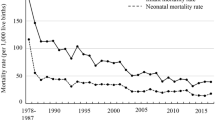Abstract
OBJECTIVES: To estimate stillbirth, perinatal (PMR) and neonatal mortality rates (NMR) in Egypt and to assign main causes of death.
STUDY DESIGN: Data were collected from a representative sample of women who gave birth from 17,521 households which were included in the Egypt Demographic and Health Survey (EDHS) 2000. Comparisons were made between three systems for classifying causes of death.
RESULTS: The NMR was 25 per 1000 live births (17 early and eight late). Half the deaths occurred in the first two days of life. Neonatal causes of death were pre-maturity (39%), asphyxia (18%), infections (7%), congenital malformation (6%) and unclassified (29%). The PMR was 34 per 1000 births, mainly attributed to: asphyxia (44%) and prematurity (21%). The revised Wigglesworth classification agreed well with the physicians except the panel attributed more deaths to infections (20%). The WHO verbal autopsy algorithm left 48% of deaths unclassified.
CONCLUSIONS: Infant mortality in Egypt is showing an epidemiological transition with a significant decrease in mortality, resulting in a disproportionate percentage of deaths in the first week of life. Infant mortality in Egypt declined 64% from 124 per 1000 between 1974 and 1978 to 44 per 1000 between 1995 and 1999, the decline being greatest among older infants; 55% of all infant deaths occurred during the neonatal period. The neonatal mortality rate in this study was estimated to be 25 per 1000 live births.
This is a preview of subscription content, access via your institution
Access options
Subscribe to this journal
Receive 12 print issues and online access
$259.00 per year
only $21.58 per issue
Buy this article
- Purchase on Springer Link
- Instant access to full article PDF
Prices may be subject to local taxes which are calculated during checkout


Similar content being viewed by others
References
Mobarak AB, Kielmann AA, van der Most van Spijk M, Hammamy MT, Nagaty AA . Evaluating tetanus neonatorum as a child survival risk in rural Egypt in the absence of reliable cause-of-death registration. Trop Med Parasitol 1985;36(4):186–190.
Mohamed TA . Registration of births' and infants' deaths in Demo village in Fayoum governorate. J Egypt Public Health Assoc 1990;65(1–2):207–220.
El-deeb B . Evaluation of the completeness of infant death registration in Egypt. Egypt Popul Fam Plann Rev 1991;25(1):11–31.
Becker S, Waheeb Y, el-Deeb B, Khallaf N, Black R . Estimating the completeness of under-5 death registration in Egypt. Demography 1996;33(3):329–339.
Ministry of Health and Population and National Population Council. El-Zanaty F, Way A, editors Egypt Demographic Health Survey 1998. Calverton, MD: Macro International; 1999.
Ministry of Health and Population and National Population Council. El-Zanaty F, Way A, editor, Egypt Demographic Health Survey 2000. Calverton, MD: Macro International; 2001.
National Population Council. Egypt: Demographic and Health Survey, 2000. Cairo: Ministry of Health and Population; 2000.
Marsh DR, Sadruddin S, Fikree FF, Krishnan C, Darmstadt GL . Validation of verbal autopsy to determine the cause of 137 neonatal deaths in Karachi, Pakistan. Paediatr Perinat Epidemiol 2003;17(2):132–142.
Okosun IS, Dever GE . Verbal autopsy: a necessary solution for the paucity of mortality data in the less-developed countries. Ethn Dis. 2001;11(4):575–577.
Amar HS, Maimunah AH, Wong SL . Use of Wigglesworth pathophysiological classification for perinatal mortality in Malaysia. Arch Dis Child Fetal Neonatal Ed 1996;74(1):F56–F59.
Kalter HD, Burnham G, Kolstad PR, et al. Evaluation of clinical signs to diagnose anaemia in Uganda and Bangladesh, in areas with and without malaria. Bull World Health Organ 1997;75(Suppl 1):103–111.
James KS, Aitken I, Subramanian SV . Neonatal Mortality in India: Emerging Paradoxes. HCPDS 2000;10(13):2–5.
WHO publication, Regional Committee. The 56 session, September 2003;10:3.
Maternal Child Health Bureau, National Center for Health Statistics, Mortality Statistics branch. http://www.mchb.hrsa.gov/ Child Health USA 2002.
Report on the Intercountry Workshop on Developing National Capacity in Safe Motherhood Surveillance and Neonatal Health, Cairo, Egypt, 26–29 April 1999. Alexandria, World Health Organization Regional Office for the Eastern Mediterranean 1999.
Bergh AM, Pattinson RC . Development of a conceptual tool for the implementation of kangaroo mother care. Acta Paediatr. 2003;92(6):709–714.
Lane SD, Cibula D . Gender and health. In: Scrimshaw S, Albrecht G. editors Handbook of Social Studies in Health and Medicine. London, England: SAGE Publications; 2000.
El-Zanaty and Associates. Caring for Mother and Baby Campaign (During Postpartum Period/40th day) Post Knowledge, Attitudes and Practices (KAP) Survey, December 2001.
Acknowledgements
We thank the Population and Health Division, United States Agency for International Development, Cairo, Egypt, for their valuable contribution and assistance in making this study possible. The study was conducted under the auspices of the Ministry of Health and Population (MOHP), John Snow, Inc. (JSI), and the London School of Hygiene and Tropical Medicine (LSHTM) provided technical support through the Healthy Mother/Healthy Child Project, with funding by the United States Agency for International Development (USAID Project No.: 263C-00-98-00041-00), Cairo.
Author information
Authors and Affiliations
Additional information
The study was conducted with funding by the United States Agency for International Development (USAID Project No. 263C-00-98-00041-00), Cairo, Egypt.
Rights and permissions
About this article
Cite this article
Campbell, O., Gipson, R., Mohandes, A. et al. The Egypt National Perinatal/Neonatal Mortality Study 2000. J Perinatol 24, 284–289 (2004). https://doi.org/10.1038/sj.jp.7211084
Published:
Issue Date:
DOI: https://doi.org/10.1038/sj.jp.7211084
This article is cited by
-
Causes of deaths in neonates and children aged 1–59 months in Nigeria: verbal autopsy findings of 2019 Verbal and Social Autopsy study
BMC Public Health (2022)
-
When do newborns die? A systematic review of timing of overall and cause-specific neonatal deaths in developing countries
Journal of Perinatology (2016)
-
Levels, timing, and etiology of stillbirths in Sylhet district of Bangladesh
BMC Pregnancy and Childbirth (2011)
-
Birth asphyxia as the major complication in newborns: moving towards improved individual outcomes by prediction, targeted prevention and tailored medical care
EPMA Journal (2011)
-
3.2 million stillbirths: epidemiology and overview of the evidence review
BMC Pregnancy and Childbirth (2009)



